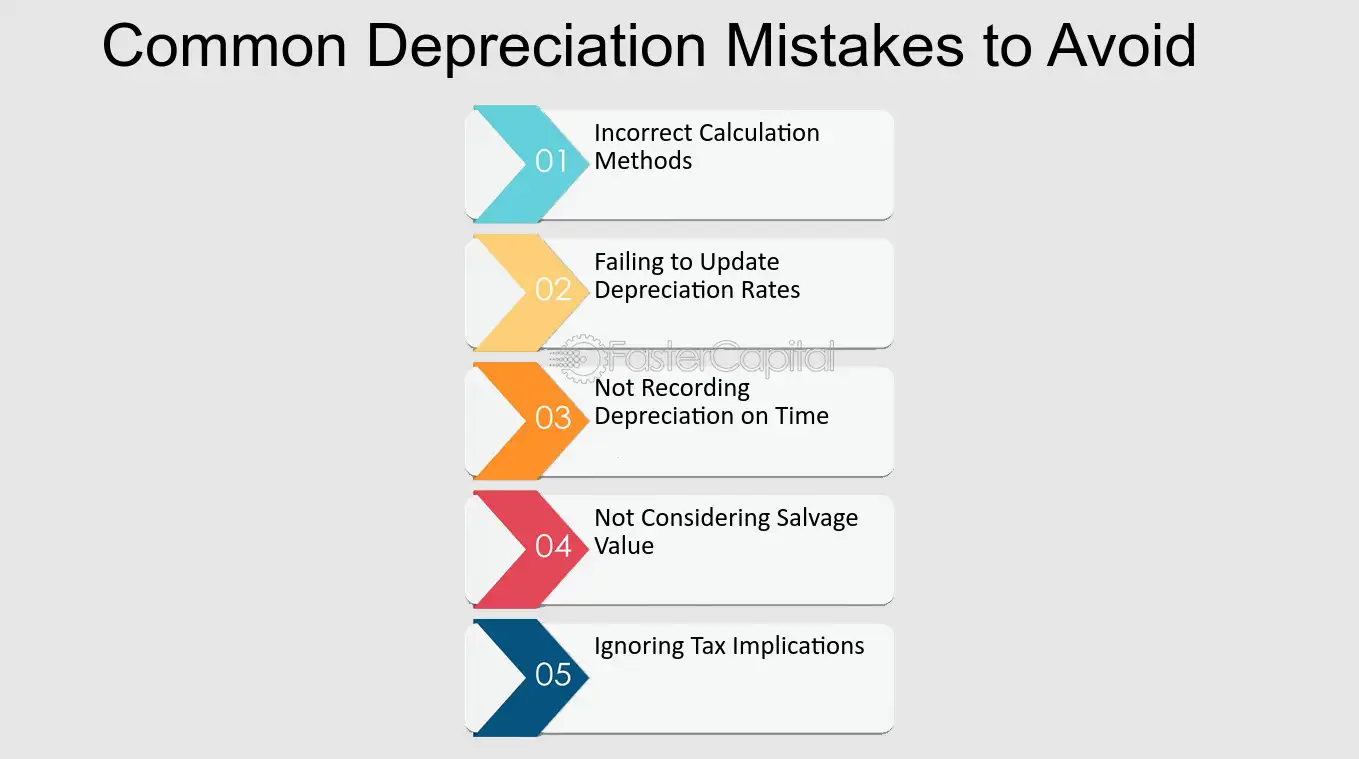When creating a tax depreciation schedule in Darwin, several common errors must be avoided to optimize deductions and compliance. First, guarantee assets are classified correctly between Capital Works and Assets, utilizing contemporary depreciation rates specific to each category. Misclassifying or using outdated rates can lead to substantial financial discrepancies. Additionally, account for joint ownership accurately by reflecting exact ownership percentages. Distinguish clearly between repairs and improvements; incorrect categorization can affect your financial reports and tax liabilities. To conclude, do not neglect the benefits of the Low Value Pool for eligible assets to accelerate depreciation. Addressing these points effectively enhances strategic asset management. Further exploration reveals additional nuances within this domain.
Misclassifying Asset Categories
One common mistake in creating tax depreciation schedule Darwin is the misclassification of asset categories, which can greatly impact the accuracy of depreciation claims. This error not only skews the financial reporting but also risks non-compliance with Australian Taxation Office (ATO) regulations, potentially leading to severe penalties. Understanding the distinction between Capital Works and Assets is paramount to ensuring depreciation accuracy.
Capital Works typically include structural elements and fixed items of a property, such as kitchen cupboards. These are depreciated over a longer period, reflecting their extended usability. In contrast, Assets comprise removable fixtures and equipment like appliances, which often have shorter lifespans and depreciate more quickly. Precise asset identification involves evaluating the physical and functional characteristics of each item, aligning them with ATO guidelines that stipulate the expected lifespans and depreciation methods.
Incorrect classification can result in under-claimed deductions, where taxpayers fail to maximize their entitlements, or over-claimed deductions, which might attract ATO scrutiny. For instance, incorrectly categorizing kitchen appliances as Capital Works would mean slower depreciation claims, thereby delaying tax benefits that could otherwise improve cash flow for property investors.
To avoid such pitfalls, property owners and tax professionals in Darwin should conduct thorough audits of property components, consulting updated ATO directives for asset classification. Utilizing detailed, itemized descriptions in tax records enhances traceability and supports compliance. Additionally, engaging with qualified quantity surveyors who specialize in tax depreciation can add an additional layer of precision to the process, safeguarding against common classification errors and ensuring that every depreciation schedule stands up to rigorous examination.
Overlooking Joint Ownership Details
Jointly owned properties in Darwin often require distinct depreciation schedules to accurately reflect each owner’s share in the investment. Understanding and implementing joint ownership considerations are crucial in guaranteeing that each owner benefits appropriately from their investment, in accordance with their ownership percentage accuracy. This adherence not only aligns with tax compliance but optimizes the fiscal advantages realized through precise depreciation claims.
When properties are jointly owned, it’s a common error to assume an even distribution of asset values. However, ownership percentages can vary, and depreciation schedules must reflect this variance to maintain accuracy. For instance, if one owner holds a 70% stake and another 30%, their depreciation claims should precisely mirror this split. Failing to do so can lead to significant discrepancies in tax liabilities and benefits.
Here is an example illustrating the importance of accurate asset splitting:
| Owner | Ownership Percentage | Depreciation Claimed |
| Owner A | 70% | $7,000 |
| Owner B | 30% | $3,000 |
| Total | 100% | $10,000 |
| Incorrect Split A | 50% | $5,000 |
| Incorrect Split B | 50% | $5,000 |
This table underscores the financial impact of incorrect depreciation allocations and emphasizes the necessity of precision in handling joint ownership details. Properly managing these details ensures that all parties maximize their entitlements without compromising legal standards. By making sure the depreciation schedules are individually tailored to each owner’s stake, investors safeguard their investments against common pitfalls and optimize their returns, fully aligning with ATO guidelines for property investment.
Ignoring Updated Depreciation Rates
Keeping abreast of the latest depreciation rates is essential for maintaining the accuracy of your tax depreciation schedule in Darwin. Update awareness is not merely about compliance; it’s a strategic approach towards maximizing your financial benefits through precise asset classification. Depreciation rates are subject to periodic adjustments which reflect changes in market conditions, usage patterns, and technological advancements. Ignoring these updates can lead to significant miscalculations.
For instance, assets such as carpets and pumps have depreciation rates that may vary depending on legislative updates or industry standards. Utilizing outdated rates for these assets can skew your financial reports and disrupt your fiscal planning. It could result in either under-claiming, which affects your cash flow by not optimizing tax deductions, or over-claiming, which could attract audits and penalties from tax authorities.
To avoid these pitfalls, it is important to implement a robust system for monitoring changes in depreciation rates. This involves regularly reviewing legal publications, subscribing to updates from the Australian Taxation Office, and possibly consulting with tax professionals who specialize in property and asset management. Each asset should be correctly classified according to its type and usage to ensure that the applicable depreciation rates are accurately applied.
Moreover, maintaining an accurate and up-to-date depreciation schedule not only safeguards against financial discrepancies but also enhances the overall asset management strategy of your business or property investment in Darwin. This strategic foresight in update awareness and precise asset classification fortifies your financial integrity, ensuring that every claim made is justifiable and strategically sound.
Misidentifying Repairs as Improvements
While updating depreciation rates safeguards the financial integrity of a tax depreciation schedule, accurately distinguishing between repairs and improvements is equally essential to avoid misclassification and ensure compliance with tax laws. Misidentifying repairs as improvements can distort the financial reporting and tax obligations of a property to a great extent. Understanding depreciation and its tax implications requires a detailed analysis of the nature of each expense incurred.
Repairs, by definition, are works undertaken to maintain the property in its current condition, such as fixing a leaky faucet or replacing broken windows. These are generally deductible immediately in the year they are incurred. Improvements, however, enhance the property’s value or extend its life—like adding a new swimming pool or renovating a kitchen—and must be depreciated over the life of the asset.
The distinction holds considerable tax implications. Classifying a repair as an improvement could defer tax benefits, as the costs are recovered over a longer period, rather than providing immediate relief. This misclassification can also attract scrutiny from the Australian Taxation Office (ATO), leading to audits or reassessments.
To avoid these pitfalls, property owners should maintain clear documentation of all expenditures. Engaging a Quantity Surveyor can provide an expert evaluation of works undertaken and ensure that each is classified correctly in accordance with ATO guidelines. This professional assessment helps in framing a tax depreciation schedule that accurately reflects the true value and state of the property assets, thereby supporting compliant and efficient tax reporting.
Neglecting the Low Value Pool
One common oversight in preparing tax depreciation schedules is neglecting the Low Value Pool, a method that greatly speeds up depreciation deductions for assets priced between $300 and $1,000. This neglect can result in slower tax benefit realization and reduced cash flow improvements, which are critical for maintaining a healthy financial status in property investments.
The Low Value Pool offers an accelerated depreciation rate, which is particularly advantageous for maximizing tax benefits and enhancing cash flow. Here are the key benefits of integrating the Low Value Pool into your depreciation schedule:
- Essential Cash Flow: By accelerating depreciation, property owners can increase their deductible expenses in the short term, leading to a reduction in taxable income and an increase in cash on hand.
- Optimized Tax Benefits: Assets included in the Low Value Pool depreciate at a higher rate, allowing investors to realize tax savings more quickly. This strategy can greatly enhance the overall return on investment.
- Strategic Asset Management: Utilizing the Low Value Pool allows for more effective financial planning and asset management. It encourages investors to strategically acquire low value assets that can be depreciated faster, thereby optimizing their investment portfolio.
It is important to confirm that your tax depreciation schedule provider includes the Low Value Pool option, as not all do. Ensuring its inclusion can lead to substantial tax savings and a better return on investment, which is essential for achieving long-term financial security in property investments. Ignoring this can result in missed opportunities for depreciation acceleration and reduced financial efficacy.
Conclusion
To sum up, the development of an accurate tax depreciation schedule demands meticulous attention to detail and adherence to regulatory guidelines. Misclassification, oversight of joint ownership, disregard for current depreciation rates, incorrect identification of repairs versus improvements, and the underutilization of the low value pool all represent significant pitfalls.
Is it not crucial, then, to guarantee that these common mistakes are avoided to maximize financial benefits and uphold the integrity of the tax depreciation process?

